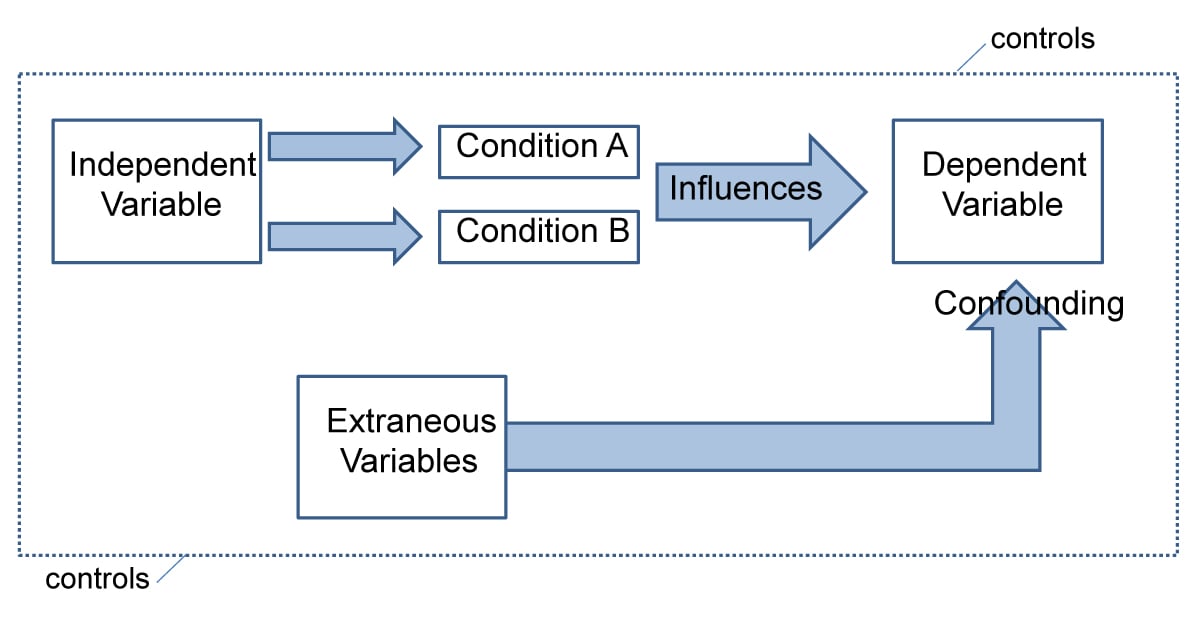On This Page:
A confounding variable is an unmeasured third variable that influences, or “confounds,” the relationship between an independent and a dependent variable by suggesting the presence of a spurious correlation.
Confounding Variables in Research
Due to the presence of confounding variables in research, we should never assume that a correlation between two variables implies causation.
When an extraneous variable has not been properly controlled and interferes with the dependent variable (i.e., results), it is called a confounding variable.

For example, if there is an association between an independent variable (IV) and a dependent variable (DV), but that association is due to the fact that the two variables are both affected by a third variable (C). The association between IV and DV is extraneous.
Variable C would be considered the confounding variable in this example. We would say that the IV and DV are confounded by C whenever C causally influences both the IV and the DV.
In order to accurately estimate the effect of the IV on the DV, the researcher must reduce the effects of C.
If you identify a causal relationship between the independent variable and the dependent variable, that relationship might not actually exist because it could be affected by the presence of a confounding variable.
Even if the cause-and-effect relationship does exist, the confounding variable still might overestimate or underestimate the impact of the independent variable on the dependent variable.
Reducing Confounding Variables
It is important to identify all possible confounding variables and consider their impact of them on your research design in order to ensure the internal validity of your results.
Here are some techniques to reduce the effects of these confounding variables:
- Random allocation: randomization will help eliminate the impact of confounding variables. You can randomly assign half of your subjects to a treatment group and the other half to a control group. This will ensure that confounders have the same effect on both groups, so they cannot correlate with your independent variable.
- Control variables: This involves restricting the treatment group only to include subjects with the same potential for confounding factors. For example, you can restrict your subject pool by age, sex, demographic, level of education, or weight (etc.) to ensure that these variables are the same among all subjects and thus cannot confound the cause-and-effect relationship at hand.
- Within-subjects design: In a within-subjects design, all participants participate in every condition.
- Case-control studies: Case-control studies assign confounders to both groups (the experimental group and the control group) equally.
Example
Suppose we wanted to measure the effects of caloric intake (IV) on weight (DV). We would have to try to ensure that confounding variables did not affect the results. These variables could include the following:
- Metabolic rate: If you have a faster metabolism, you tend to burn calories more quickly.
- Age: Age can affect weight gain differently, as younger individuals tend to burn calories quicker than older individuals.
- Physical Activity: Those who exercise or are more active will burn more calories and could weigh less, even if they consume more.
- Height: Taller individuals tend to need to consume more calories in order to gain weight.
- Sex: Men and women have different caloric needs to maintain a certain weight.
Frequently asked questions
1. What is a confounding variable in psychology
A confounding variable in psychology is an extraneous factor that interferes with the relationship between an experiment’s independent and dependent variables. It’s not the variable of interest but can influence the outcome, leading to inaccurate conclusions about the relationship being studied.
For instance, if studying the impact of studying time on test scores, a confounding variable might be a student’s inherent aptitude or previous knowledge.
2. What is the difference between an extraneous variable and a confounding variable?
A confounding variable is a type of extraneous variable. Confounding variables affect both the independent and dependent variables. They influence the dependent variable directly and either correlate with or causally affect the independent variable.
An extraneous variable is any variable that you are not investigating that can influence the dependent variable.
3. What is Confounding Bias?
Confounding bias is a bias that is the result of having confounding variables in your study design. If the observed association overestimates the effect of the independent variable on the dependent variable, this is known as a positive confounding bias.
If the observed association underestimates the effect of the independent variable on the dependent variable, this is known as a negative confounding bias.
References
Glen, Stephanie. Confounding Variable: Simple Definition and Example. Retrieved from StatisticsHowTo.com: Elementary Statistics for the rest of us! https://www.statisticshowto.com/experimental-design/confounding-variable/
Thomas, L. (2021). Understanding confounding variables. Scribbr. Retrieved from https://www.scribbr.com/methodology/confounding-variables/
University of Michigan. (n.d.). Confounding Variables. ICPSR. Retrieved from https://www.icpsr.umich.edu/web/pages/instructors/setups2012/exercises/notes/confounding-variable.html

